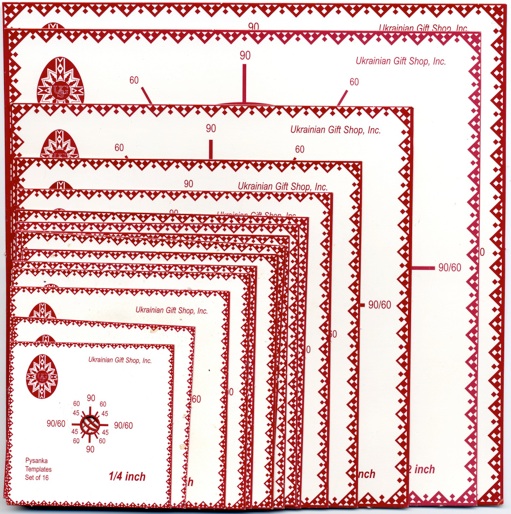Templates

These simple paper templates, produced by the Ukrainian Gift Shop and sold by any pysanka retailers, are incredibly useful items. I bought my first set years ago, and used it to draw an occasional circle. That set mostly lay around gathering dust.
I didn’t really see the point of having them, as I rarely needed circles on my pysanky, and never particularly large ones. And then one day I realized how useful these templates really were!!
They are useful for drawing circles, but not just circles in designs. Rather, they made the perfect guide lines for drawing stars with perfect (or as close as a mere mortal can get) radial symmetry!
Radial symmetry is the type of symmetry found in an apple:
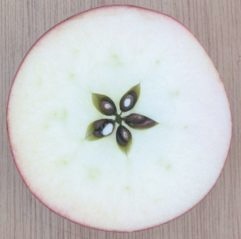
or in these starfish:

These examples are both of five-fold symmetry. But radial symmetry can be three, four, six, seven (or any other version of n-fold (when n is 3 or greater)!
The most common motif on Ukrainian pysanky is the eight-pointed star, the ancient symbol of Dazhboh, the sun god. This version of it exhibits perfect eight-fold symmetry:
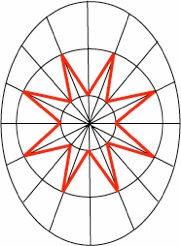
The UGS templates can be used to draw the guide lines for objects with radial symmetry. If you carefully examine a template, you will notice the markings around the circle:
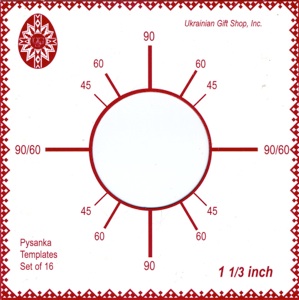
If you remember basic geometry, you will recall that there are 360 degrees in a circle. So, if you want x number of divisions, you need to divide 360 by x. Therefore:
2 divisions = 180 degrees
3 divisions = 120 degrees
4 divisions = 90 degrees
6 divisions = 60 degrees
8 divisions = 45 degrees
In other words, if you want to divide your circle into six parts, put a mark at each of the “60” marks. (This is the division you would use for snowflakes.) If you want to divide your circle into eight parts, put a mark at each of the 45 degree marks. (This is the division you would use for a “sun” star or ruzha / “rose”.) You then connect your marks with pencil and have your divisions!
Since there are no 180 or 120 degree marks, you have to use a bit of simple math and/or common sense. For 120 (thirds), mark every other 60; for 180 (halves), mark every other 90.
NOTE: Odd divisions (3, 5, 7, etc.) are rarely seen in traditional pysanky, and there are no markings on the templates to help you draw then. To create these divisions, you will ned to either eyeball them, or to use a compass and a bit of geometry to figure it out.
The egg needs to be stabilized (held very still) in order to use the templates successfully. Holding the egg with one hand doesn’t work, unless you are a three (or more) handed individual. Since one hand holds the template in place, and the other holds the pencil, you would need a third hand to keep the egg from rolling away.
I put the egg sideways across a cup in an egg carton – paper seems to work best, but styrofoam will do as well. (See photo below.) The carton will hold the egg in place while you draw. (I also have a plastic egg holder that I often use, which a friend got for me from a medical laboratory – it was disposable packaging material. You can see it in some of the photos below.) Mind, you don’t need to use a whole egg carton – I find a section of it works just as well, as long as it is large enough to be stable and not tip over (at least 2 cups long).
I usually draw the straight division lines first with a lathe, and then apply my circles. I then center the circles on the templates over the division lines on my egg, as Fuzz demonstrates here:
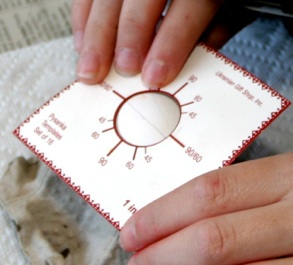
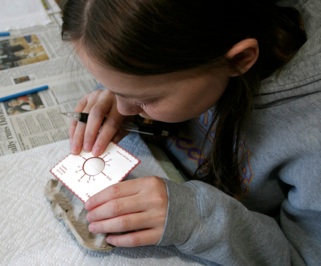
In this case, there is just one line running through the circle. Note that the line on the egg lines up with the markings on the template! Holding the template in place with my left hand, Fuzz draws in the circle:
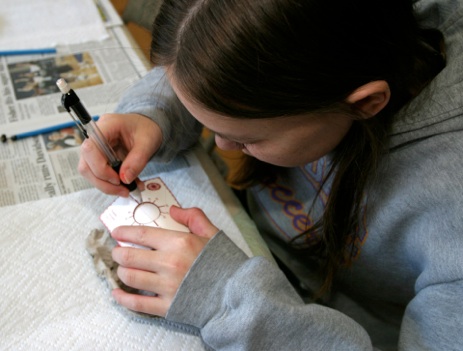
The result is this egg:

The same procedure, but centering and drawing the circle over a pair of crossed lines:


Once the circle is drawn, the markings for the desired division can be added. You can also use several different-sized templates to draw concentric circles, as in this egg:
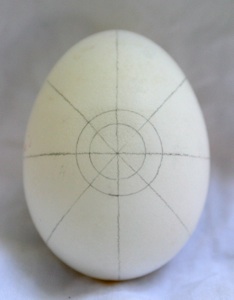
These circles have been divided into eight 45° sections; they will be used to apply concentric eight-pointed stars to the pysanka:
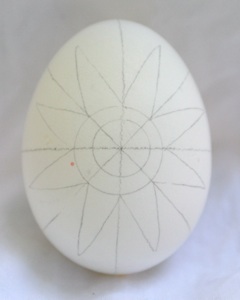


Note: You can also use the flexible plastic circle templates made for drafting. They give a much wider range of circle sizes, which can be quite useful, but are larger and а біт more awkward to use. They are much more widely available, both through office supply stores and crafts stores. I often use my Staedler template, as it has a large range of smaller sized circles:

The disadvantage of using these plastic templates is that the divisions of the circle, when present, are minimal–the one shown above only divides the circle into four. This template is great for drawing smaller circles onto an egg, but not for dividing the circle.
Back to Main Pencil Lines page
Back to Main Pysankarstvo page
Search my site with Google
Using Templates
